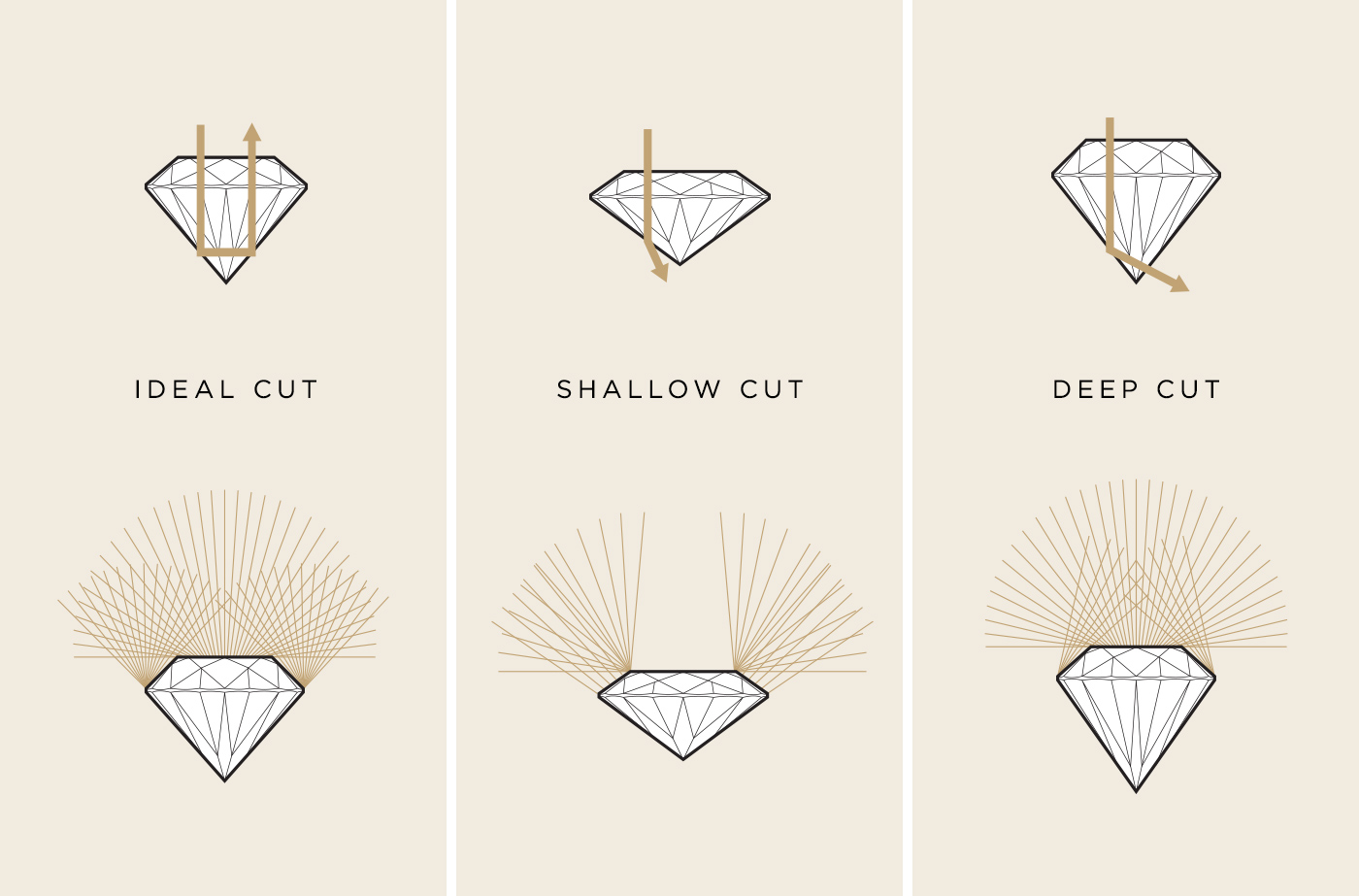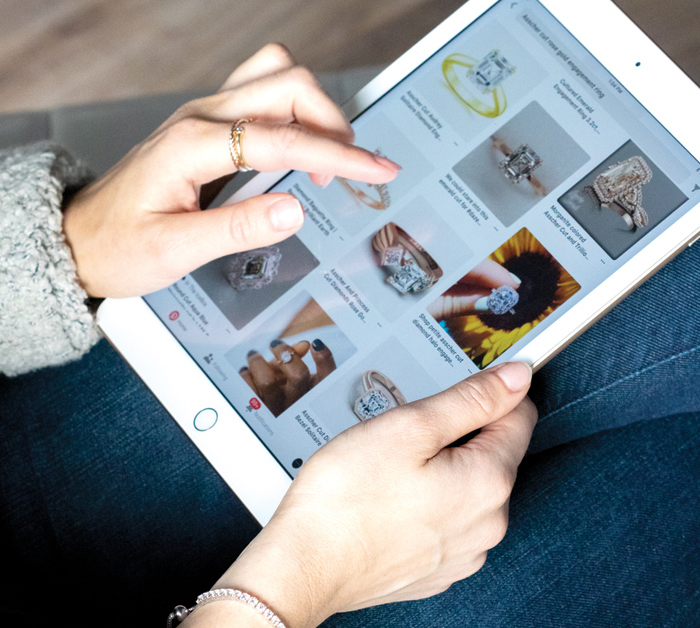How to Choose a Diamond
September 29th, 2019 / Alese Oldenburg
Shopping For The Perfect Gem
Like clothes and hairstyles, jewelry tends to ebb and flow with trends – your go-to look this summer might look entirely different a year later. Colors and styles of necklaces, earrings, and bracelets may change as your tastes do, but diamond and simulated diamond jewelry are delightfully different. Perhaps it’s the way it shines and sparkles in the light, its timeless place as a symbol of devotion and loyalty, or its long-lasting durability that makes it so indelible. Regardless of the reasoning behind its staying power, one thing is certain: choosing a diamond is a very important decision.
How To Pick A Diamond
While size tends to be the point that most diamond-picking decisions seem to orbit, especially when it comes to engagement rings, the reality is it’s not a particularly important aspect. If you dislike the cut, color, and clarity of your selected stone, the carat size could be staggering but it wouldn’t make a lot of difference. These four attributes, commonly called the “4 Cs” of diamond buying, define how a particular stone looks and reflects the light, giving discerning shoppers a specific target to aim for. When shopping for a diamond with your local jeweler or online, you may want to consider these four tried-and-true questions:

What color do you want your stone to be? While “white” does help place your quest on a side of the scale, it doesn’t really define the color stone you’d like. Some diamond fans prefer a bright, clear white, while others enjoy the intriguing play of light in certain colored options, such as canary Nexus Color Stones. These two options (and everything in-between) can be mixed and matched within the same setting, as well. These mixed designs may bring together a large central stone and smaller flanking or accent stones, as commonly seen in pavé diamond jewelry.

What shape would you like for your stone? From radiant cut engagement rings to round cut engagement rings, the stone options are abundant. Learning the types of diamond shapes available will help you shop more accurately for your dream stone. Different shapes have decidedly different “feelings” to their look: a princess cut diamond is a crisp, modern, and straight-edged design for a contemporary look, while an asscher cut, alternately, evokes a romantic impression that would be right at home in the roaring ‘20s. You’ll need to determine an overall diamond shape – circular, oval, rectangular, square, etc. – and explore cuts within that shape. The way a diamond “glitters” depends largely on its shape and faceting – in other words, the angular cuts made in the body of the gem that reflect light. An excellent cut can bring out a diamond’s best qualities and minimize flaws, while a poor cut can do the opposite. A little research prior to selecting a diamond will help avoid the latter by highlighting the best cuts for your desired stone and purpose. It may also point you in the direction of a lab diamond simulant such as the Nexus Diamond alternative, which features an Ideal cut in all stones since they’re created in a lab.
Where will your stone sit in its setting? When determining what to look for in a diamond, some jewelry fans neglect to weigh the stone’s “roommate” – the setting itself. No matter how a stone is cut or what carat size it may be, the wrong setting can ruin the effect of its brilliance. Too deep in the setting, and rounded-edge cuts may be obscured or dulled by metal prongs. Too high in the setting, and the stone may be at risk of being damaged or dislodged, particularly if it’s being worn every day. The stone itself may also affect the way light flows in and out – look for an Ideal Cut that balances width and depth for the best play of light within the stone.

What type of jewelry will your stone be set in? Certain cuts and different diamond shapes are more well-suited to certain jewelry designs. Square cut and princess-cut diamonds, for example, are classic inclusions for tennis bracelets due to their clean lines and edge-to-edge brilliance. Asscher cut diamonds and round brilliant cuts shine beautifully as matching stud earring solitaires or as awe-inspiring engagement rings. If you’re planning on buying several pieces of diamond jewelry at once, matching cuts will help establish a cohesive design.

How is your diamond sourced? Eco-conscious and culturally-conscious diamond jewelry has become one of the most well-known ways to practice ethical buying. Because buying a diamond is a special and typically rare experience, it affords a unique opportunity to put your money where your mouth is in terms of conscious buying. Mined diamonds may come from areas of conflict, or may be extracted using mining methods that damage ecosystems, while stones like Nexus Diamond alternatives are conflict-free for both beauty and a peaceful consumer conscience.
How To Choose A Diamond On A Budget
Diamonds are considered the most precious and rare cut gems. Not so long ago, they were only available from select mines and jewelers. This diamond network closely guarded their sources, shipping the stones across oceans and continents to be cut and sold. The high cost of mined diamonds today still reflects this secrecy, even though the buying and selling of mined diamonds have become a considerably more transparent practice in the interim. That’s a challenge for diamond shoppers with a budget in mind and can make the process feel more like a chore sifting through price options than the joyful occasion it should be.

The emergence of alternatives like Diamond Nexus has given cost-conscious consumers a different choice, and the ability to buy gorgeous stones without being priced out over cut, clarity, color, or carat weight. With more buying power, breathtaking pieces ranging from timeless engagement rings to sparkling pendants and even loose diamond alternatives are more affordable. Rather than a simple pair of diamond studs, for example, a loving spouse might be able to pick more ornate pear-shaped Nexus Diamond alternative earrings to surprise their partner, or even two pairs for special occasions. It’s no longer a requirement to break the bank in exchange for diamond quality. You can still find a gorgeous diamond that will sparkle and inspire attention at a price that doesn’t turn heads as well.
To find the perfect intersection of your desired budget and a beautiful stone, determine approximately how much you’d like to spend on your finished diamond jewelry piece. That number will help guide you to the perfect diamond or diamond alternative, whether it’s a necklace, ring, bracelet, or even a loose stone destined for a custom setting.
If you aren’t sure about your diamond budget just yet, that’s perfectly okay too! You can start your search by finding styles and designs that appeal to you – this will give you a “ballpark” figure that you can adjust up or down as you continue the hunt for your perfect stone. Remember, while size should definitely factor into your overall decision on a stone, attributes like diamond clarity and cut will make all the difference in the finished effect of diamonds, regardless of their size. You should avoid starting the diamond-buying process with “size blinders” on because it’s very likely you’ll miss an absolutely breathtaking smaller stone.
Finding Diamonds For A Loved One

Buying diamond jewelry for a friend, family member, or romantic partner is an incredibly thoughtful and personal gift. While the very act of gifting diamond jewelry is enough to make any lucky recipient’s day, there are a few considerations that can make your gift even more special:
Consider bringing the recipient into the shopping process. Surprises are nice, of course, but getting a piece of jewelry that truly reflects their tastes may be even better. It’s very common for modern couples to openly discuss and shop for engagement rings together, for example. The actual “popping of the question” can remain a surprise, even if the ring is picked out well beforehand.
If you want to keep the surprise intact, look to their friends or family members. Best friends will know and understand your recipient’s preferred diamond styles, as will close family members. At the very least, they should be able to narrow down choices to eliminate ill-fitting options from your diamond-buying efforts.
If you’re worried about friends and family spilling the beans, a little sleuthing will help the cause. Look to existing jewelry for clues and guidance, and be sure to pay attention to any comments they make about diamonds or jewelry. Aesthetic-based social media accounts like Pinterest and Instagram will also help you get to know the preferred style a little better.
If your diamond jewelry isn’t engagement or wedding-related, a sentimental touch can go a long way. Consider looking for pieces that celebrate your loved one’s life and achievements in a meaningful manner. For example, a special engraving inside a ring band can be used for commemoration or adding a corresponding number of accent stones to a design can represent the number of children they have.
No matter which diamond jewelry you select for your recipient, make sure to retain all the paperwork associated with the purchase. Not only will this help with insurance valuation in the event of a loss or theft, but it will also keep your recipient connected with the manufacturer. In the event a sizing or repair is needed, they’ll be able to quickly and easily track down the manufacturer for guidance or service.
When you buy diamond jewelry for a friend, family member, or loved one, you’re giving them something they’ll treasure forever. Not only are you honoring the special connection you share with a gorgeous diamond or diamond alternative, but you’re also offering an enduring jewelry piece that will last a lifetime.
Finding Diamonds For Yourself

If you’re purchasing your diamond alternative or diamond jewelry as a present to yourself, the experience of selecting a stone will be different. You’ll need to answer the important questions about fit, color, size, and cut as you would shopping for someone else, but you’ll also need to be truthful with yourself. Ask yourself questions like:
Will I still love this design if my personal style changes to more formal / more casual?
Is this jewelry appropriate for the workplace or everyday wear?
If I plan on wearing it every day, is the piece easy to clean and maintain?
If I don’t plan on wearing it every day, will I wear it often enough for it to be a good purchase?
Can this piece be engraved or customized the way I’d like it to be?
If there is a size issue or difference (e.g. pre-versus-post pregnancy rings), can I have this piece sized with relative ease?
Buying diamond alternative or diamond jewelry for yourself is an empowering and pleasantly indulgent act, ideal for celebrating milestones like a birthday, a promotion at work, a life goal achieved, or a special trip taken. The meaning behind your chosen stone can be shared with the world or held in the heart – either way, the brilliant sparkle will commemorate it forever.
Shopping For Loose Diamonds
If you already have a jewelry setting on hand, whether it’s a sentimental heirloom or a modern design that caught your eye, buying a loose stone will help you complete the look. With both diamond and diamond alternative stones readily available to browse online, the only limit is your imagination. If you’re pursuing this route in your jewelry purchasing journey, be sure to record any setting measurements available for accuracy; a local jeweler or jewelry repair center should be able to give you measurements if you don’t already have them.

Once you have your setting measurements in hand, the fun begins: deciding on a cut, color, and size of stone to fit right in the heart of it. If you’re planning on setting more than one stone – for example, a pair of earrings, or several matching pieces of jewelry – it’s a good idea to reach out to the seller for recommendations. This way, you can rest assured that your entire fine jewelry collection will look absolutely stellar.
Summary: The Art & Science Of Diamond Selection
Knowing how to pick the perfect diamond or diamond simulant, whether it’s for your own taste or a recipient’s, is as much an art as it is a science. From the depths of the sparkling cut to the gorgeous color of the stone itself, there are many factors to navigate, but each is more rewarding than the next. If you’re starting on your diamond journey, Nexus Diamond alternative pieces are an ideal place to find your perfect gemstone. Much like the connections you make and your contributions to the world, each stone is multi-faceted, eye-catching, and dazzling – and will continue to be for a lifetime.
*Diamond Nexus strives to provide valuable information, while being clear and honest about our products. The Nexus Diamond™ alternative is a patented lab created diamond simulant that, among all simulants, most closely imitates the look, weight and wear of a diamond, with two exceptions – it is absolutely perfect in every way, and it costs significantly less. Price points and environmental facts expressed in this blog were taken from popular online retailers and may vary. Learn more about the environmental impact of mining by visiting our blog.
1 “Insider’s Guide to Determine Cut Quality And Selecting a Diamond for Ideal Light Performance.”Beyond4cs.com, (no publish date), https://beyond4cs.com/step-by-step-guide/determining-the-cut-of-a-diamond/. Accessed August 16, 2019.
2 Fried, Michael. “The 7 Step Guide to Buying a Diamond.” The Diamond Pro, August 8, 2019, https://www.diamonds.pro/education/diamond-buying-guide/. Accessed August 16, 2019.
3 “How To Buy A Diamond.” GIA 4cs.gia.edu, (no publish date), https://4cs.gia.edu/en-us/diamond-buying-guide/. Accessed August 16, 2019.

